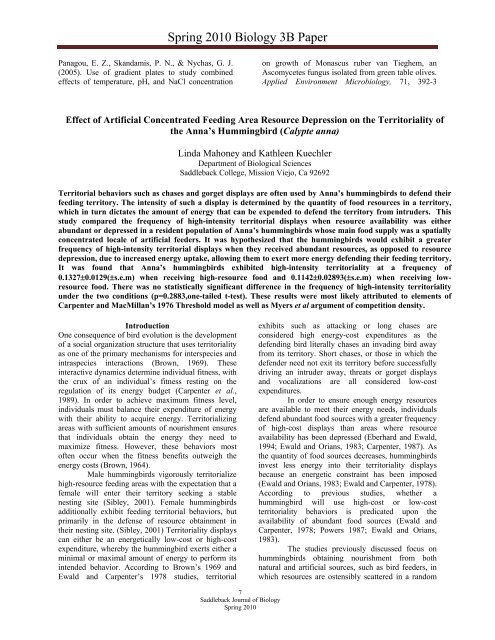Saddleback Journal of Biology - Saddleback College
Saddleback Journal of Biology - Saddleback College
Saddleback Journal of Biology - Saddleback College
You also want an ePaper? Increase the reach of your titles
YUMPU automatically turns print PDFs into web optimized ePapers that Google loves.
Spring 2010 <strong>Biology</strong> 3B Paper<br />
Panagou, E. Z., Skandamis, P. N., & Nychas, G. J.<br />
(2005). Use <strong>of</strong> gradient plates to study combined<br />
effects <strong>of</strong> temperature, pH, and NaCl concentration<br />
on growth <strong>of</strong> Monascus ruber van Tieghem, an<br />
Ascomycetes fungus isolated from green table olives.<br />
Applied Environment Microbiology, 71, 392-3<br />
Effect <strong>of</strong> Artificial Concentrated Feeding Area Resource Depression on the Territoriality <strong>of</strong><br />
the Anna’s Hummingbird (Calypte anna)<br />
Linda Mahoney and Kathleen Kuechler<br />
Department <strong>of</strong> Biological Sciences<br />
<strong>Saddleback</strong> <strong>College</strong>, Mission Viejo, Ca 92692<br />
Territorial behaviors such as chases and gorget displays are <strong>of</strong>ten used by Anna’s hummingbirds to defend their<br />
feeding territory. The intensity <strong>of</strong> such a display is determined by the quantity <strong>of</strong> food resources in a territory,<br />
which in turn dictates the amount <strong>of</strong> energy that can be expended to defend the territory from intruders. This<br />
study compared the frequency <strong>of</strong> high-intensity territorial displays when resource availability was either<br />
abundant or depressed in a resident population <strong>of</strong> Anna’s hummingbirds whose main food supply was a spatially<br />
concentrated locale <strong>of</strong> artificial feeders. It was hypothesized that the hummingbirds would exhibit a greater<br />
frequency <strong>of</strong> high-intensity territorial displays when they received abundant resources, as opposed to resource<br />
depression, due to increased energy uptake, allowing them to exert more energy defending their feeding territory.<br />
It was found that Anna’s hummingbirds exhibited high-intensity territoriality at a frequency <strong>of</strong><br />
0.13270.0129(s.e.m) when receiving high-resource food and 0.11420.02893(s.e.m) when receiving lowresource<br />
food. There was no statistically significant difference in the frequency <strong>of</strong> high-intensity territoriality<br />
under the two conditions (p=0.2883,one-tailed t-test). These results were most likely attributed to elements <strong>of</strong><br />
Carpenter and MacMillan’s 1976 Threshold model as well as Myers et al argument <strong>of</strong> competition density.<br />
Introduction<br />
One consequence <strong>of</strong> bird evolution is the development<br />
<strong>of</strong> a social organization structure that uses territoriality<br />
as one <strong>of</strong> the primary mechanisms for interspecies and<br />
intraspecies interactions (Brown, 1969). These<br />
interactive dynamics determine individual fitness, with<br />
the crux <strong>of</strong> an individual’s fitness resting on the<br />
regulation <strong>of</strong> its energy budget (Carpenter et al.,<br />
1989). In order to achieve maximum fitness level,<br />
individuals must balance their expenditure <strong>of</strong> energy<br />
with their ability to acquire energy. Territorializing<br />
areas with sufficient amounts <strong>of</strong> nourishment ensures<br />
that individuals obtain the energy they need to<br />
maximize fitness. However, these behaviors most<br />
<strong>of</strong>ten occur when the fitness benefits outweigh the<br />
energy costs (Brown, 1964).<br />
Male hummingbirds vigorously territorialize<br />
high-resource feeding areas with the expectation that a<br />
female will enter their territory seeking a stable<br />
nesting site (Sibley, 2001). Female hummingbirds<br />
additionally exhibit feeding territorial behaviors, but<br />
primarily in the defense <strong>of</strong> resource obtainment in<br />
their nesting site. (Sibley, 2001) Territoriality displays<br />
can either be an energetically low-cost or high-cost<br />
expenditure, whereby the hummingbird exerts either a<br />
minimal or maximal amount <strong>of</strong> energy to perform its<br />
intended behavior. According to Brown’s 1969 and<br />
Ewald and Carpenter’s 1978 studies, territorial<br />
exhibits such as attacking or long chases are<br />
considered high energy-cost expenditures as the<br />
defending bird literally chases an invading bird away<br />
from its territory. Short chases, or those in which the<br />
defender need not exit its territory before successfully<br />
driving an intruder away, threats or gorget displays<br />
and vocalizations are all considered low-cost<br />
expenditures.<br />
In order to ensure enough energy resources<br />
are available to meet their energy needs, individuals<br />
defend abundant food sources with a greater frequency<br />
<strong>of</strong> high-cost displays than areas where resource<br />
availability has been depressed (Eberhard and Ewald,<br />
1994; Ewald and Orians, 1983; Carpenter, 1987). As<br />
the quantity <strong>of</strong> food sources decreases, hummingbirds<br />
invest less energy into their territoriality displays<br />
because an energetic constraint has been imposed<br />
(Ewald and Orians, 1983; Ewald and Carpenter, 1978).<br />
According to previous studies, whether a<br />
hummingbird will use high-cost or low-cost<br />
territoriality behaviors is predicated upon the<br />
availability <strong>of</strong> abundant food sources (Ewald and<br />
Carpenter, 1978; Powers 1987; Ewald and Orians,<br />
1983).<br />
The studies previously discussed focus on<br />
hummingbirds obtaining nourishment from both<br />
natural and artificial sources, such as bird feeders, in<br />
which resources are ostensibly scattered in a random<br />
7<br />
<strong>Saddleback</strong> <strong>Journal</strong> <strong>of</strong> <strong>Biology</strong><br />
Spring 2010

















